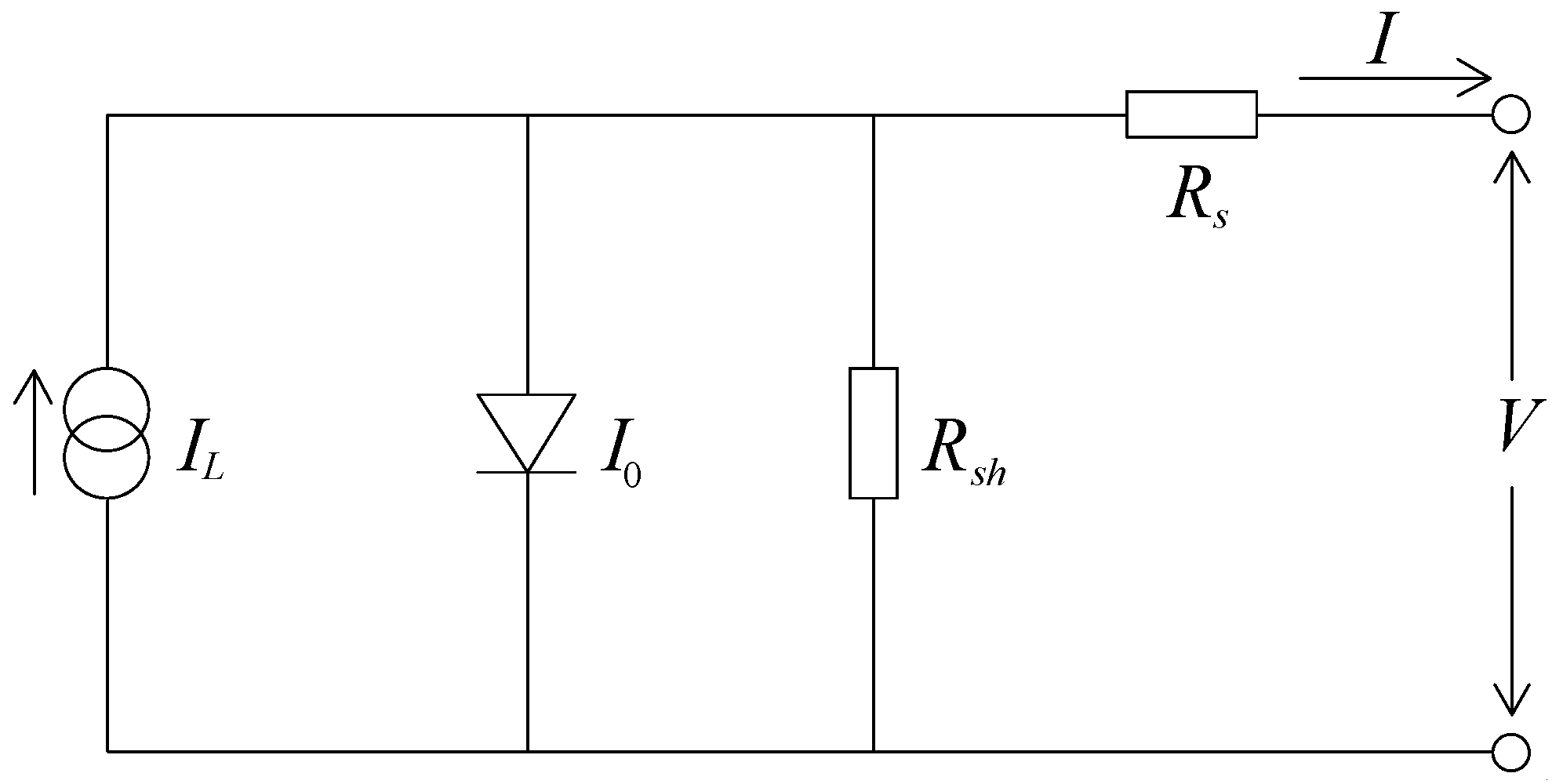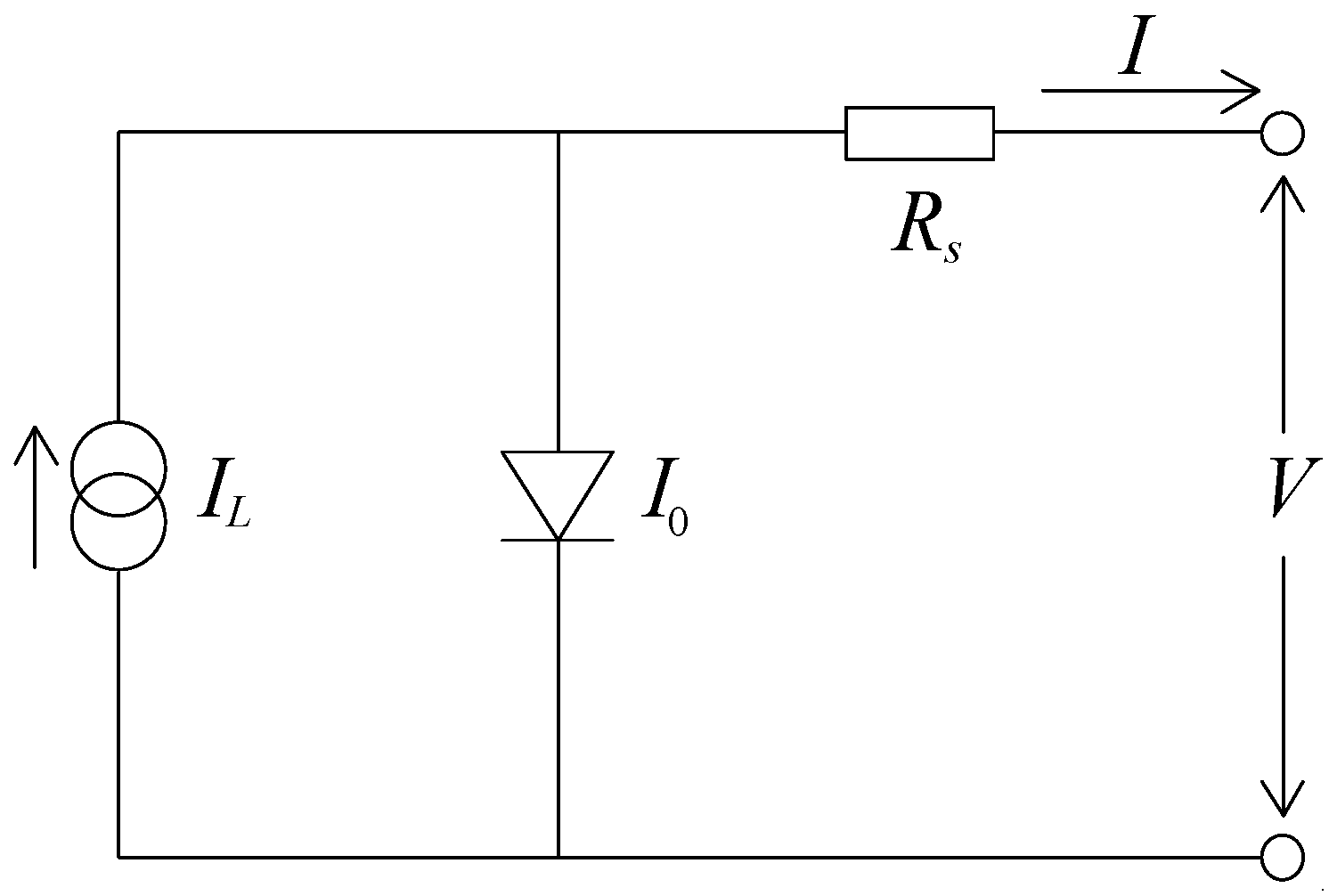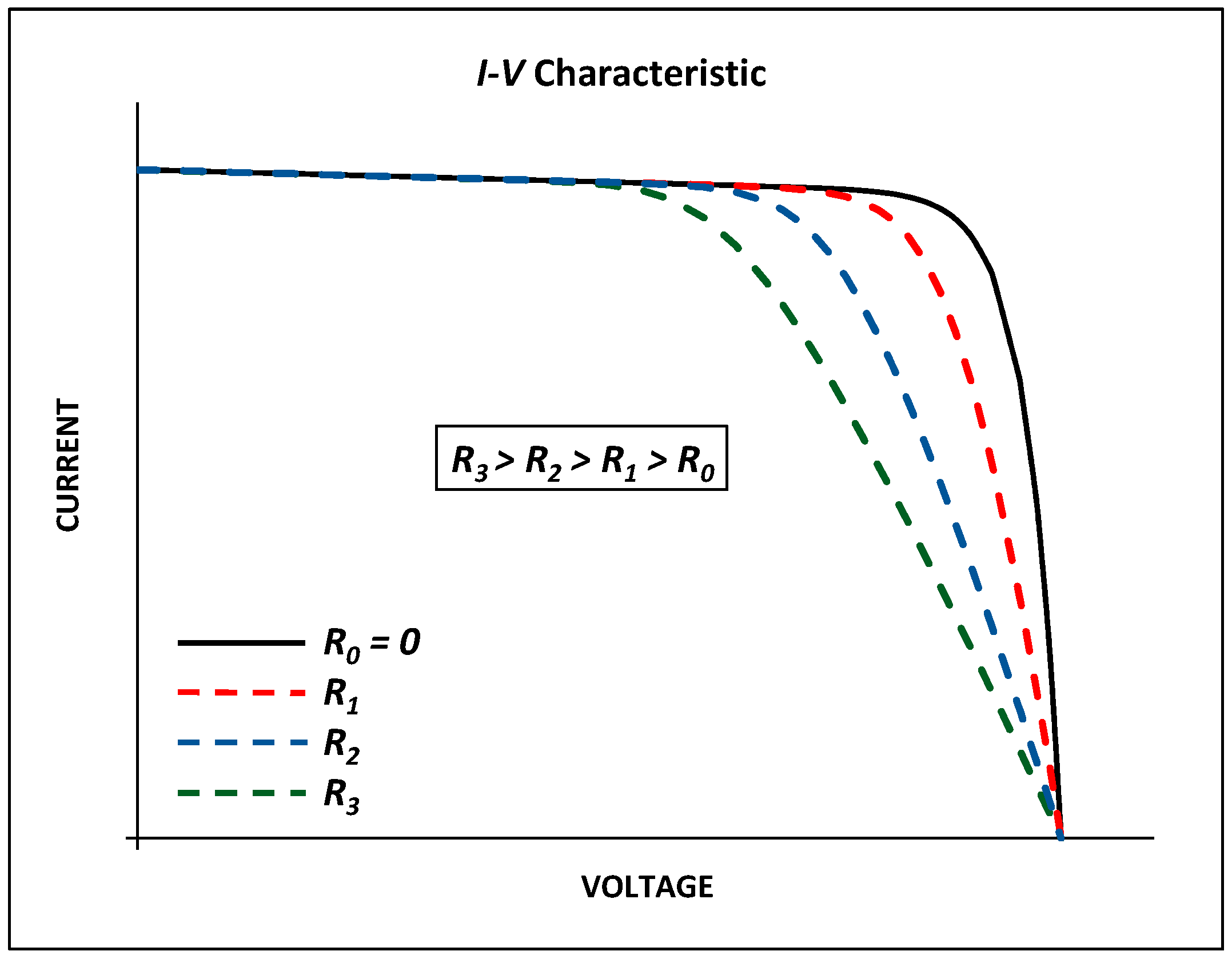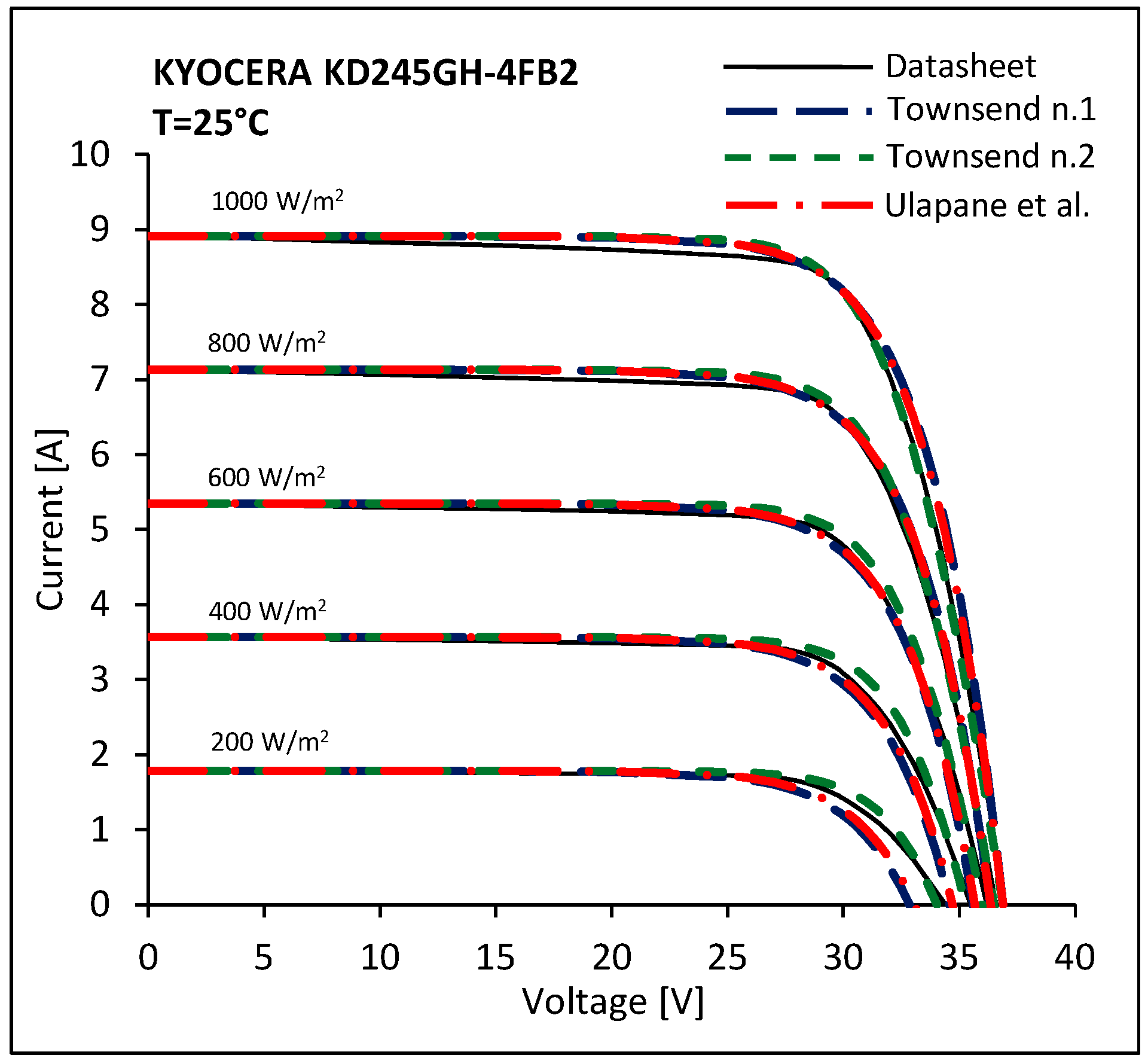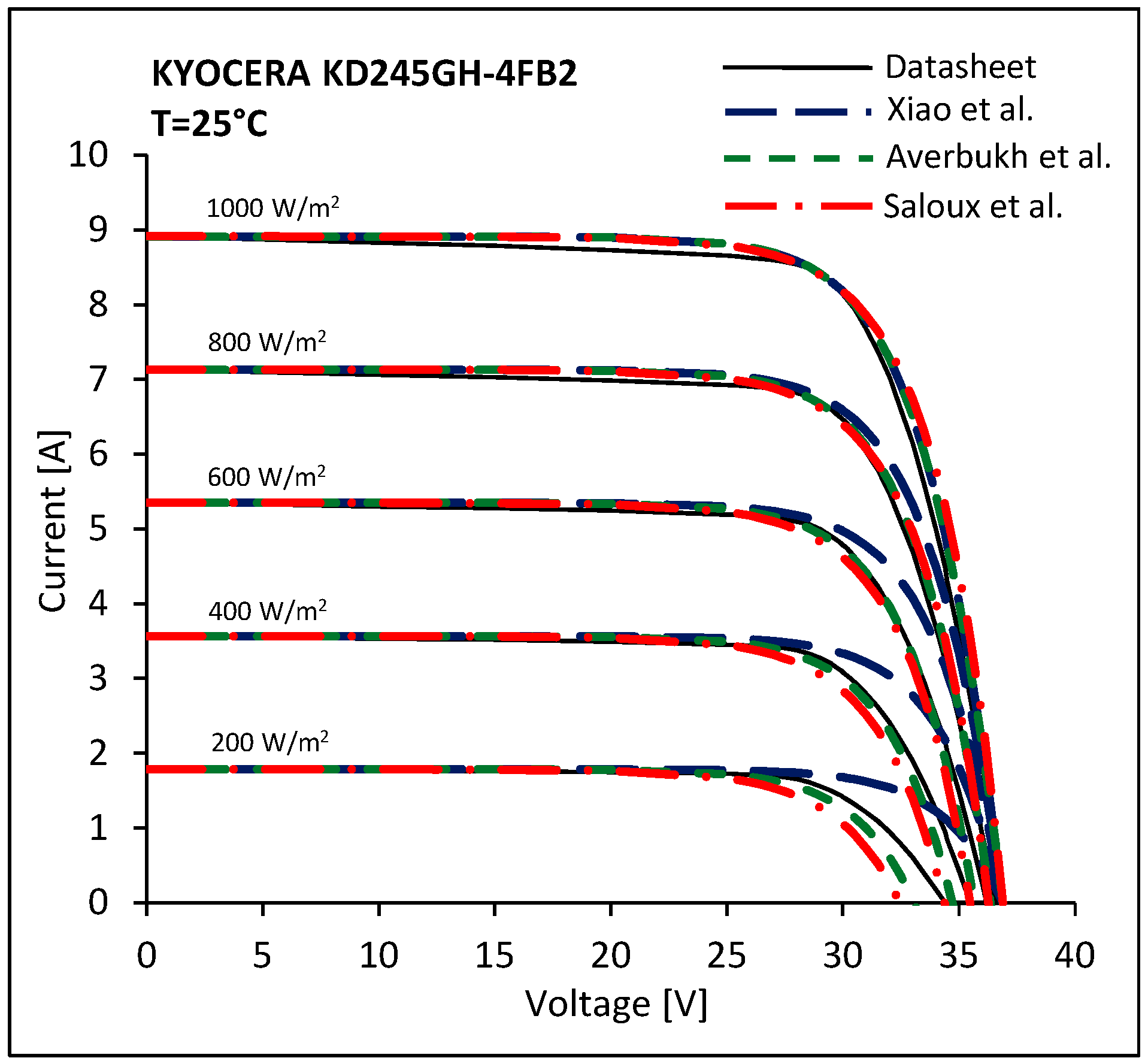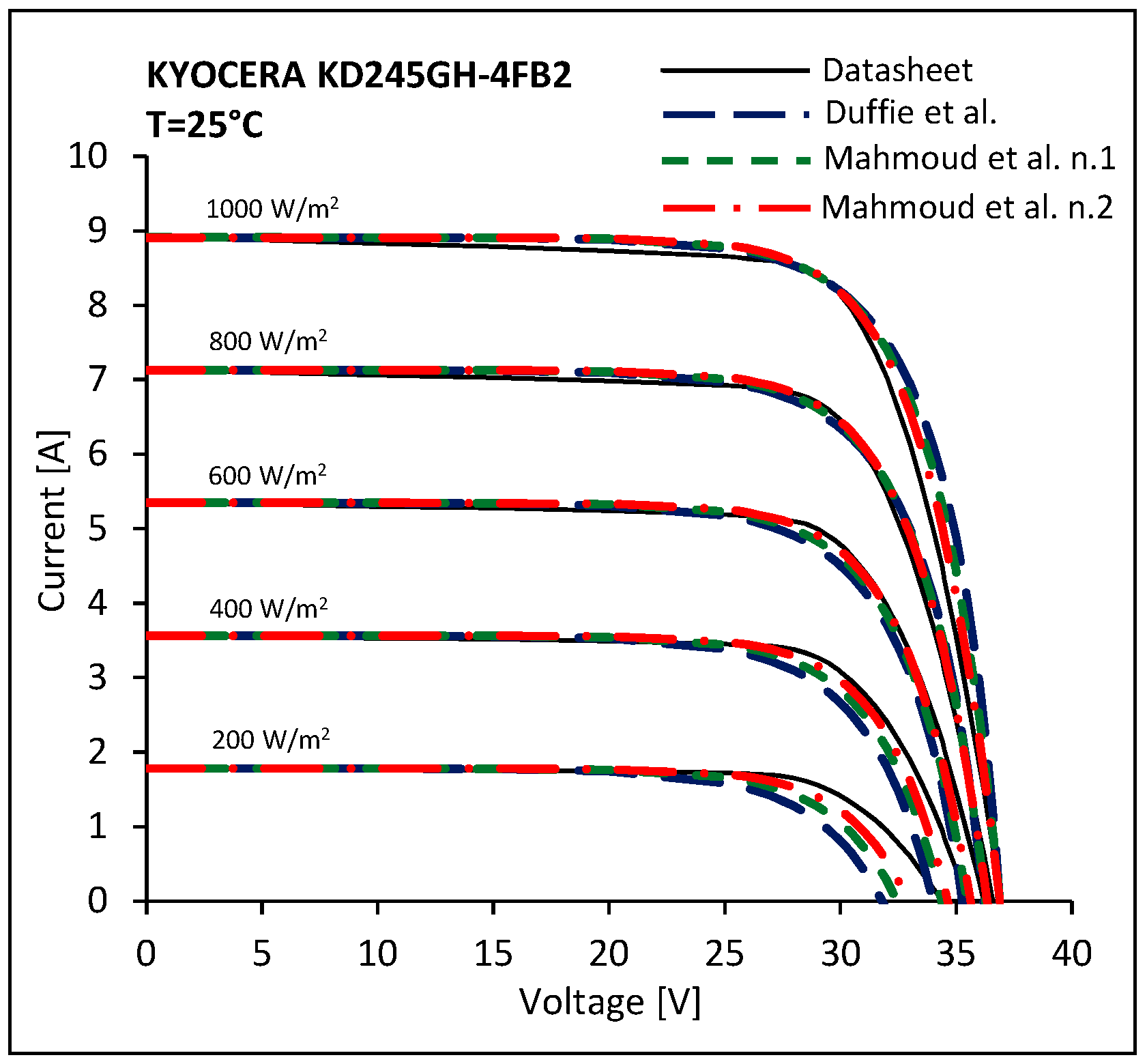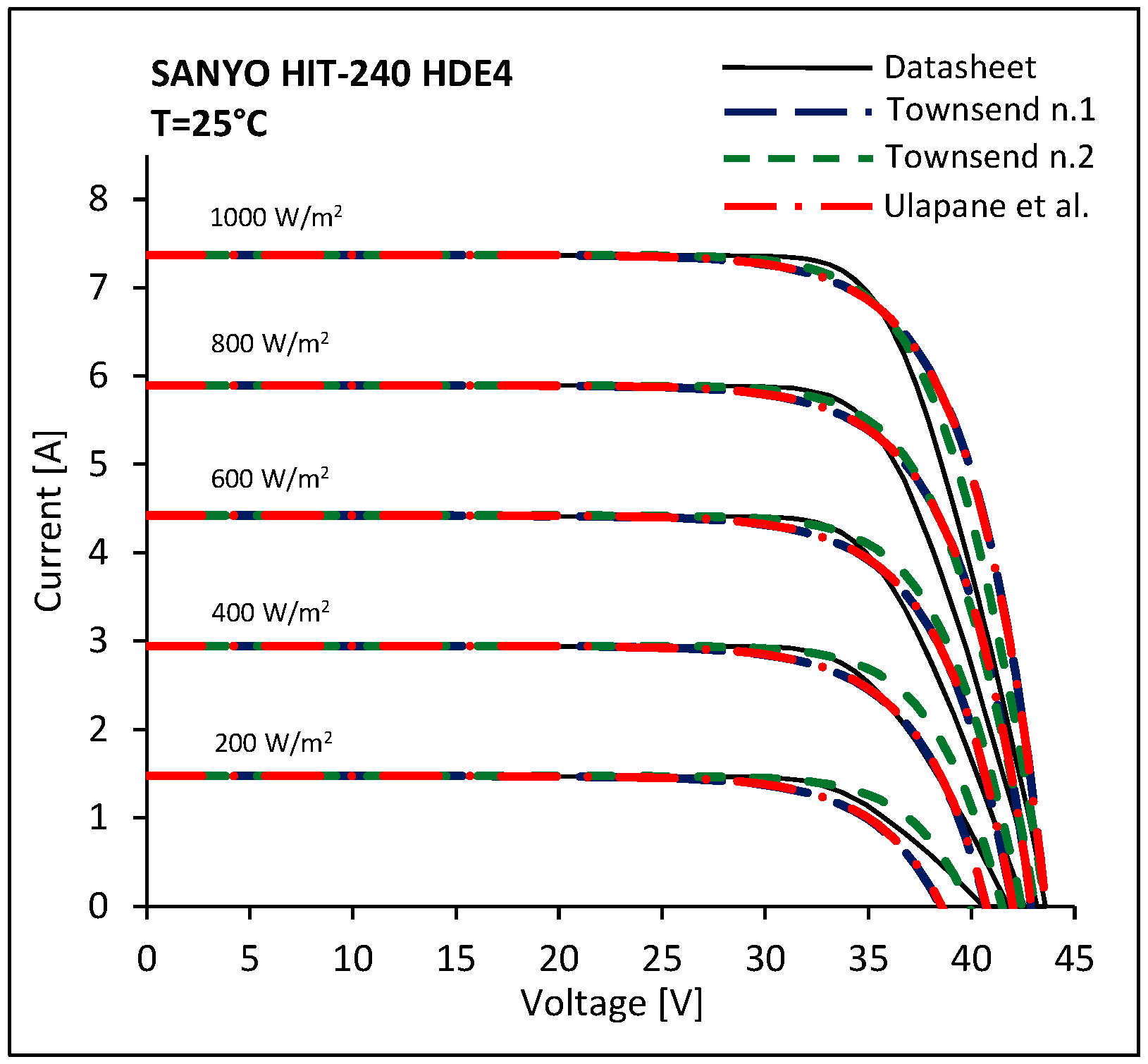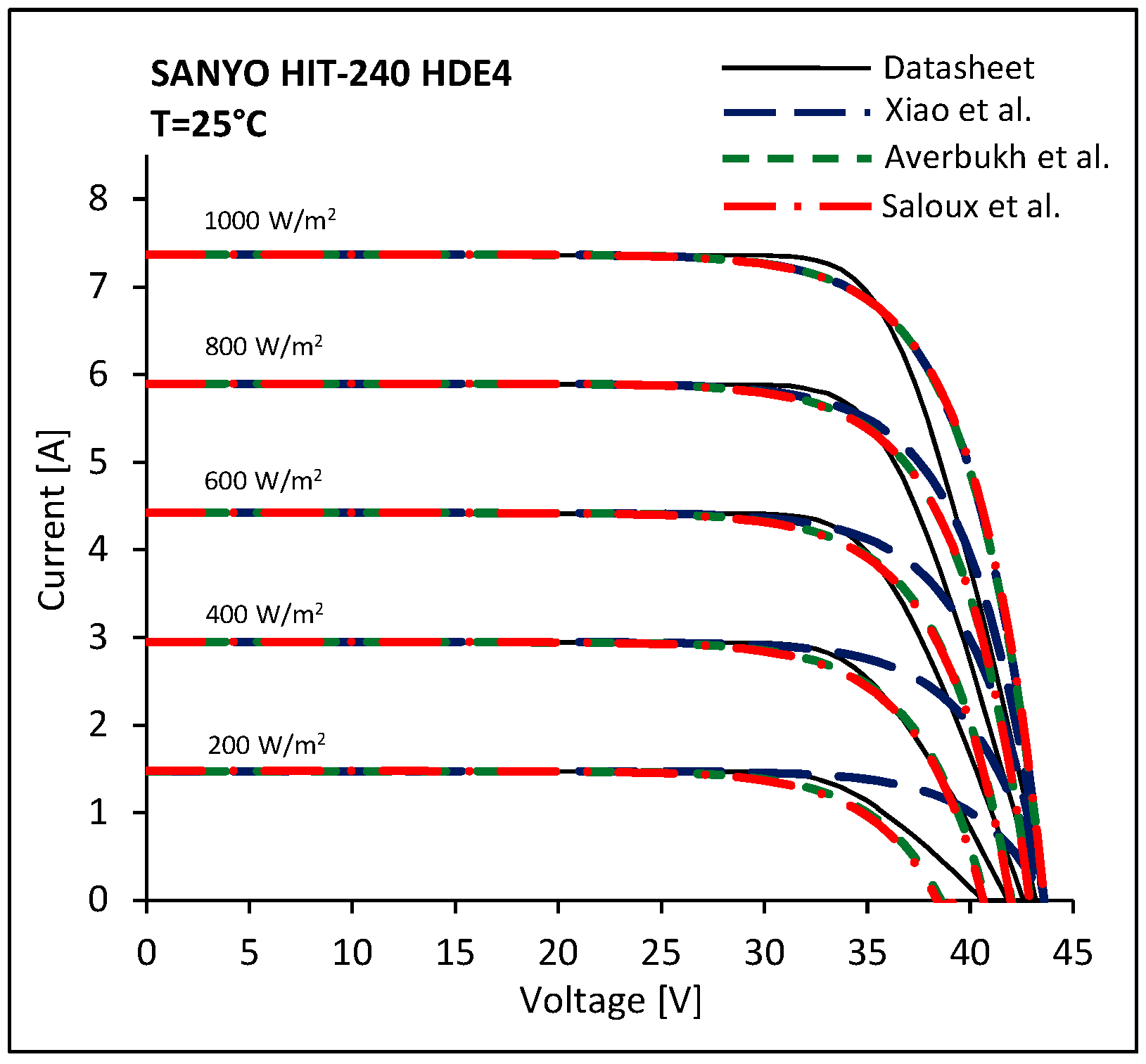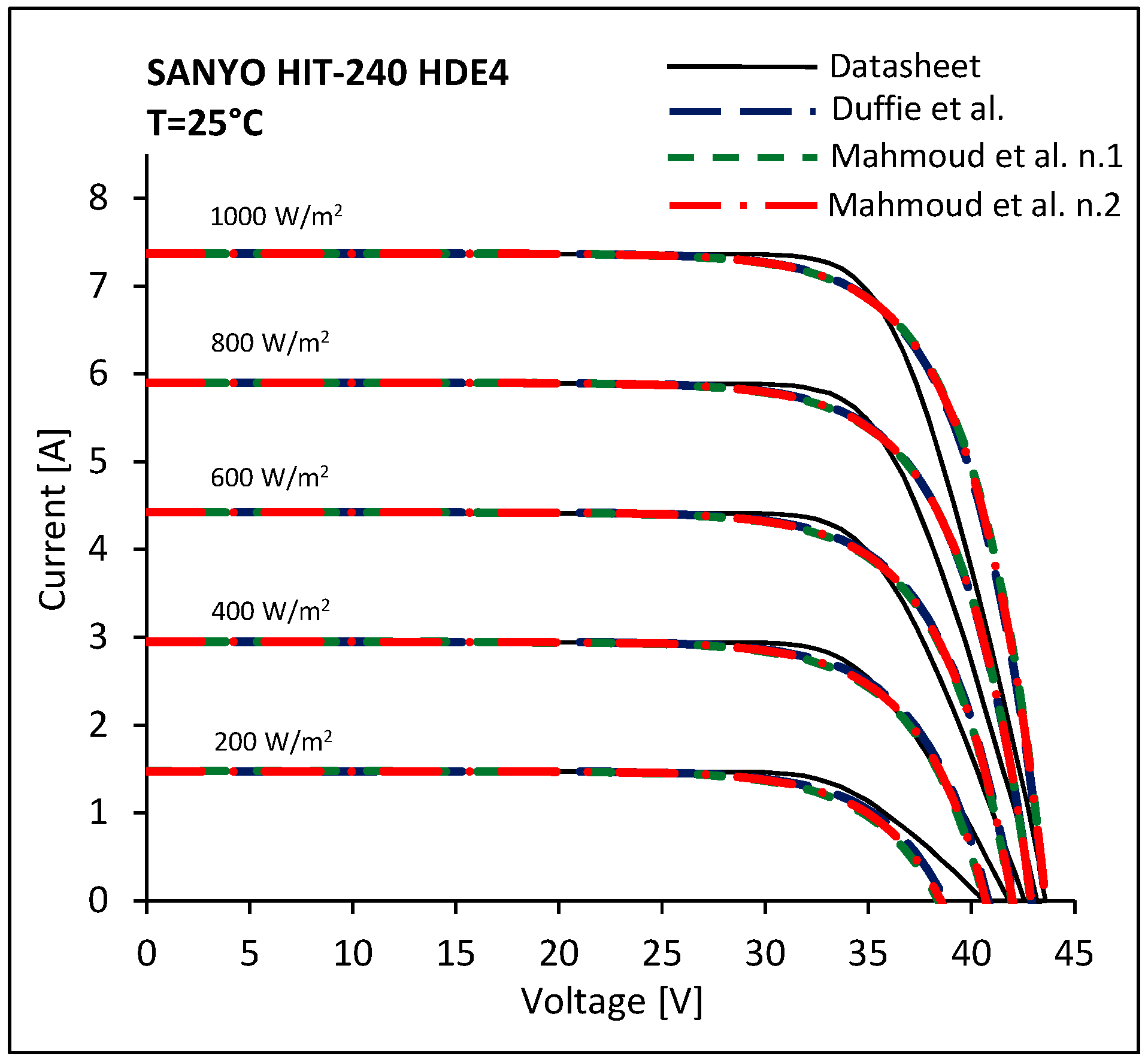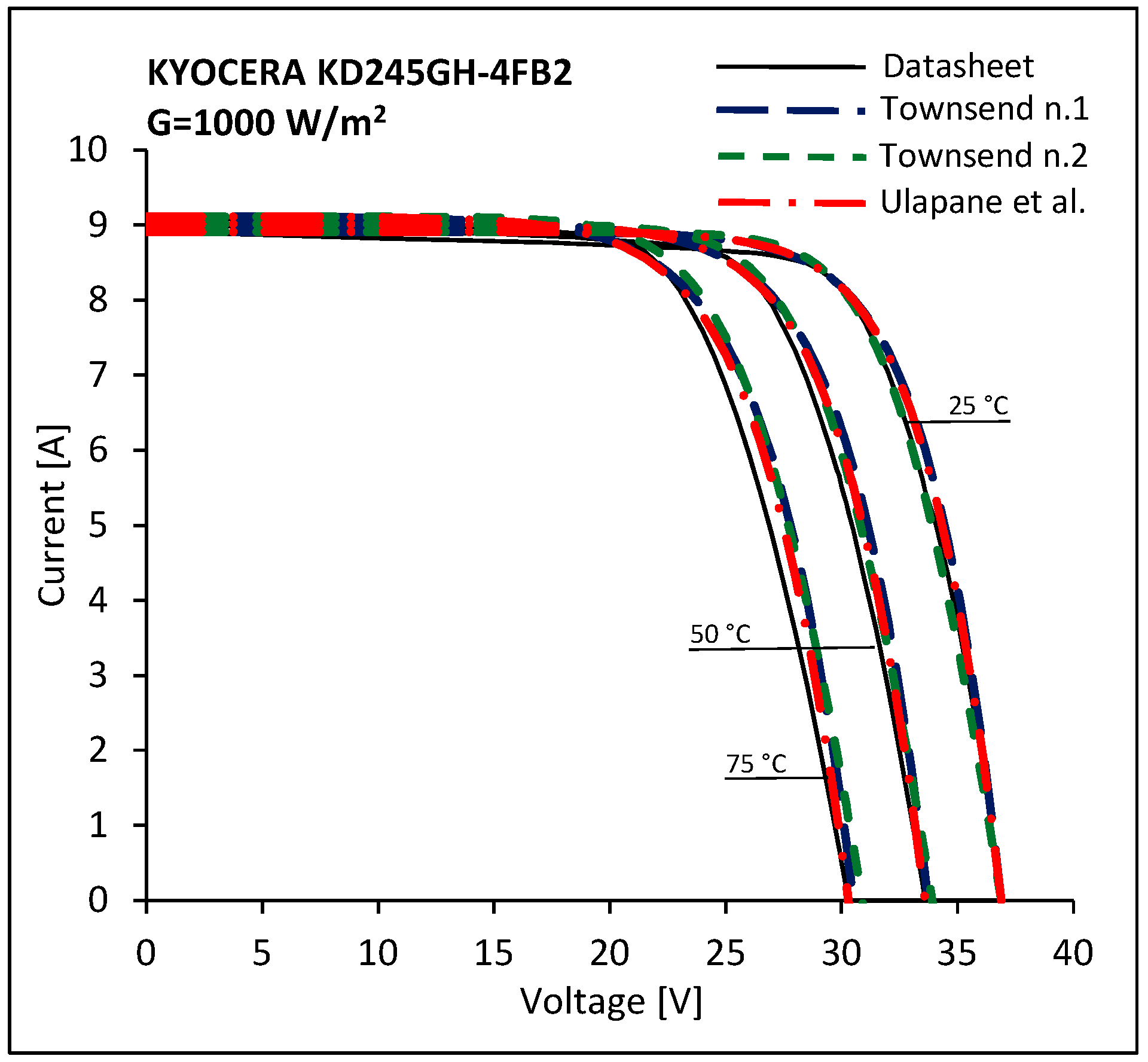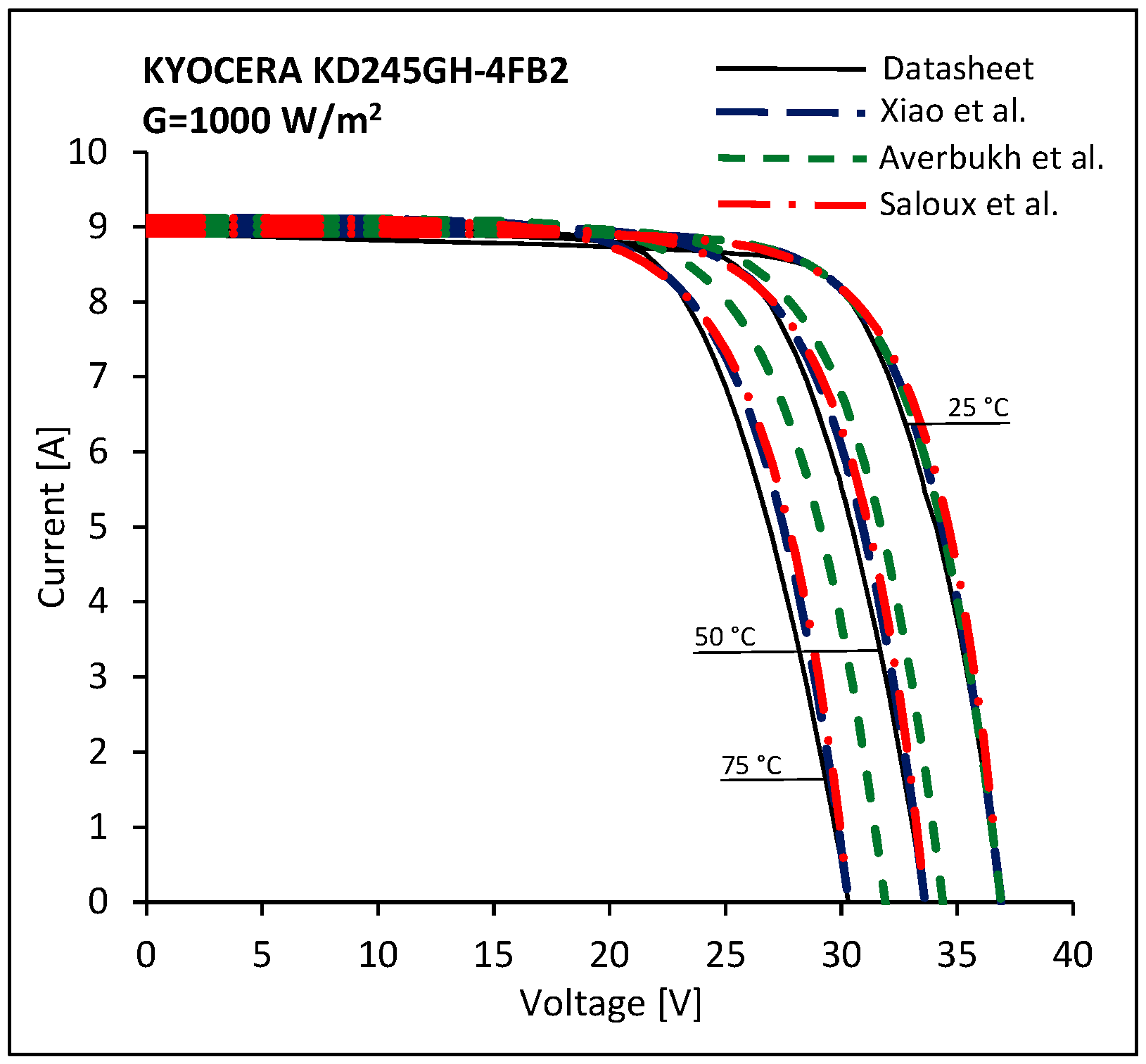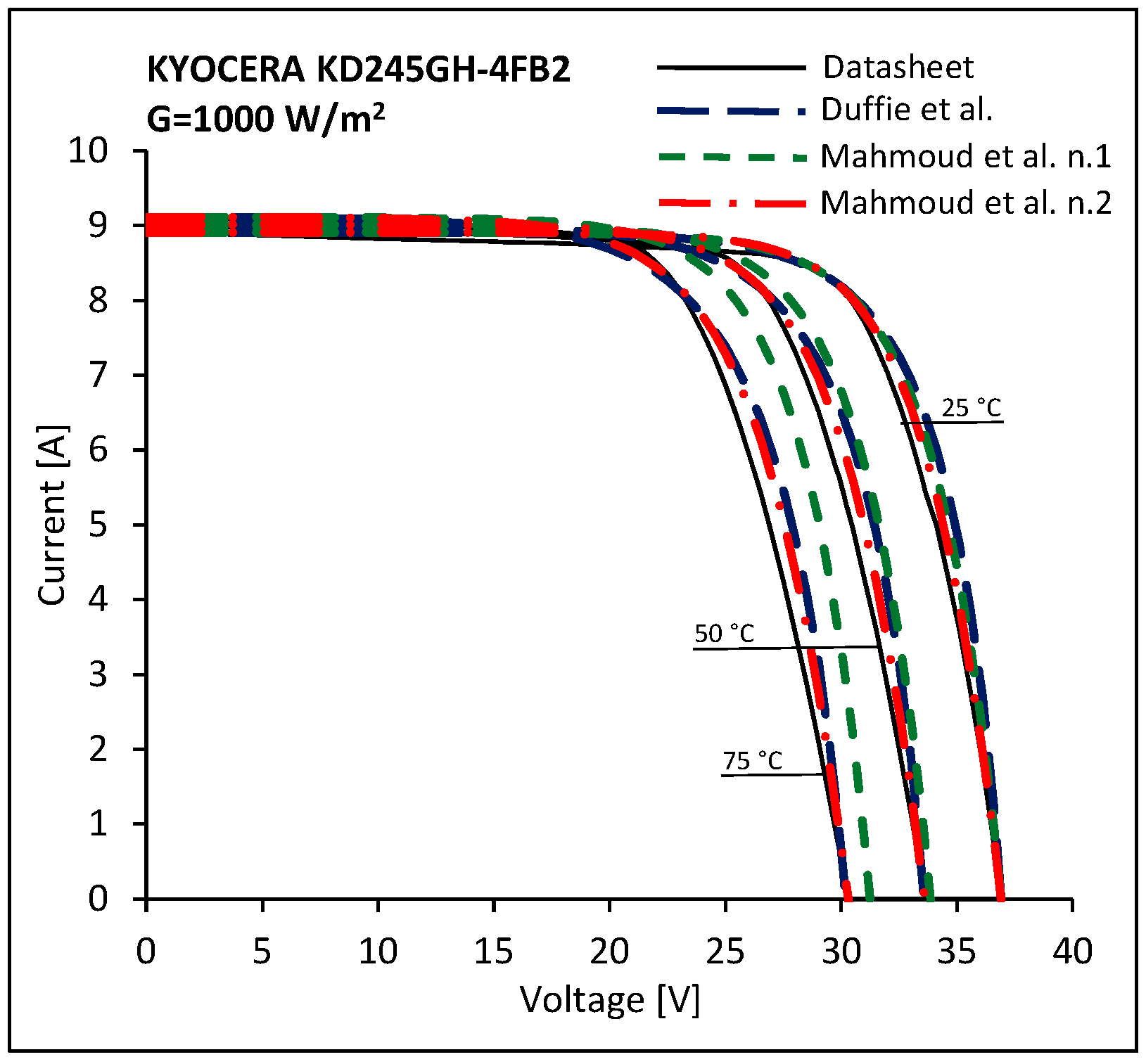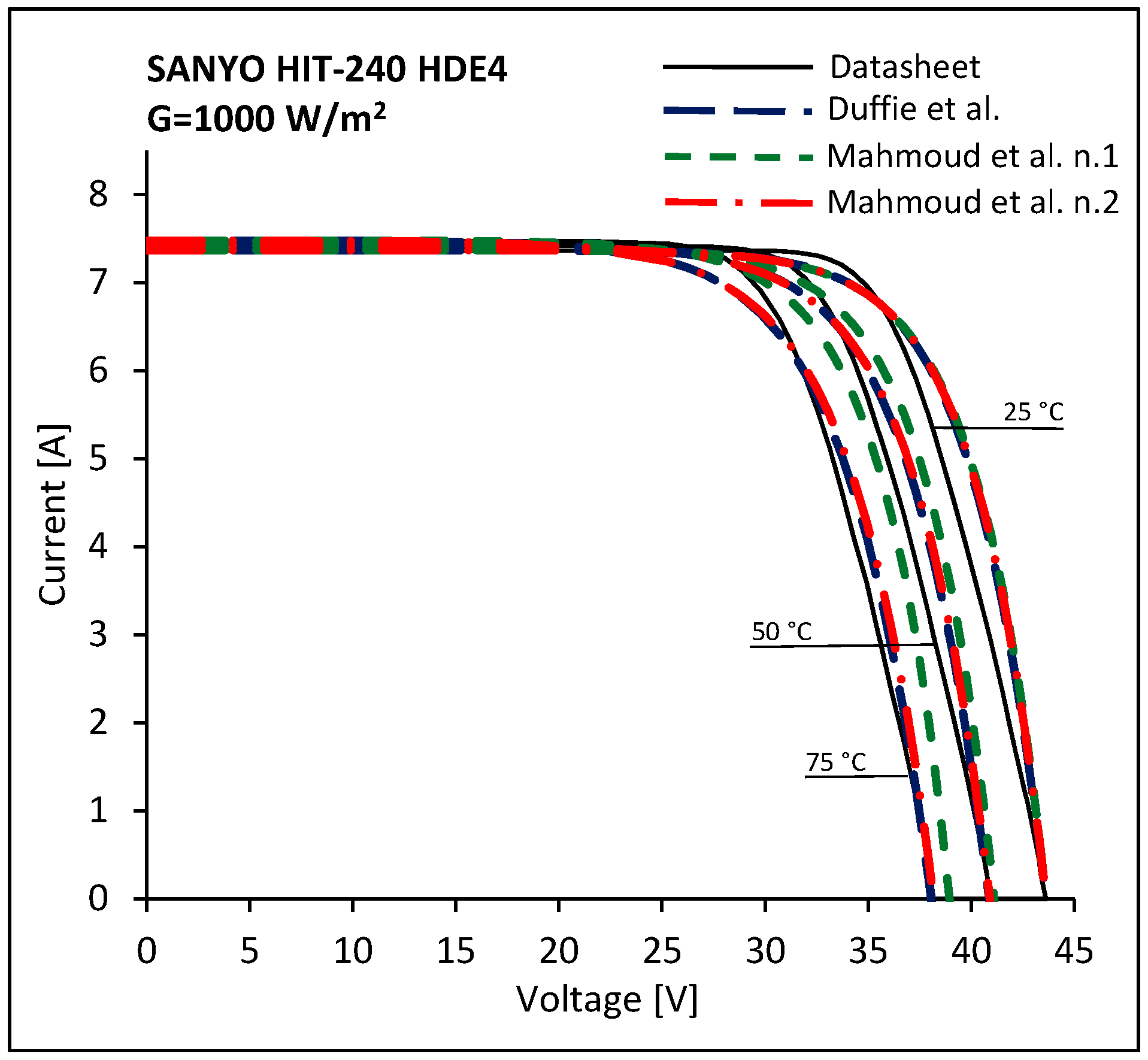1. Introduction
A mathematical model used to simulate physical behaviours of PV modules needs a compromise between analytical complexity and achievable precision [
1].
The one-diode model is a simplified version of the two-diode model proposed by Wolf [
2] in order to represent the physical structure of a PV cell. As Wolf observed, the photocurrent in a PV cell is not generated by only one illuminated diode, but it is rather the global effect of the presence of a multitude of elementary flanked diodes that are uniformly distributed throughout the surface that separates the two slabs of the semiconductor junction. For this reason, a PV cell should be realistically approximated with a distributed constant electric circuit containing a multitude of elementary lumped components such as current generators, diodes and electrical resistances. Because such an equivalent circuit would be too complex to use, a simplified equivalent circuit was adopted. The circuit, which is depicted in
Figure 1, contains only one pair of diodes with reverse saturation currents
I01 and
I02, a current generator and two resistors
Rs and
Rsh, which take account of dissipative effects and parasitic currents within the PV panel.
The second diode was added to consider the effect of the carrier recombination in the depletion region. The two-diode equivalent circuit of a PV module is described by the equation:
where, following the traditional theory, the photocurrent
IL depends on the solar irradiance, the diode saturation currents
I01 and
I02 are affected by the cell temperature,
n1 = a1Ncsk/q and
n2 = a2Ncsk/q are the diode quality factors,
a1 and
a2 are the diode shape factors,
Ncs is the number of cells of the panel that are connected in series. The values of
Rs,
Rsh,
I01 and
I02 variously affect the
I-
V characteristic of the PV panel [
3]. Because the evaluation of the parameters contained in the two-diode equivalent circuit is a complex problem, the one-diode equivalent circuit, depicted in
Figure 2, was also considered.
Many authors have proposed analytical procedures for determining the model parameters on the basis of the performance data usually provided by manufacturers [
4,
5,
6,
7,
8,
9,
10,
11,
12,
13,
14,
15,
16,
17,
18,
19,
20,
21,
22,
23,
24,
25,
26,
27,
28,
29,
30,
31,
32,
33,
34,
35,
36,
37,
38,
39,
40,
41,
42,
43,
44,
45,
46,
47,
48]. The identification of the parameters contained in the diode-based equivalent circuits has been also tackled exploring the possibility of using different procedures such as Lambert
W-function, evolutionary algorithms, Padè approximants, genetic algorithms, cluster analysis, artificial neural networks, harmony search-based algorithms, small perturbations around the operating point and reduced forms [
49,
50,
51,
52,
53,
54,
55,
56,
57,
58,
59,
60,
61,
62,
63]. Other authors have investigated some simplified versions of the one-diode equivalent circuit in order to obtain an adequate representation of the PV panel characteristics by means of a reduced number of model parameters. A large amount of simplified one-diode models, obtained by changing the used set of performance data, the adopted hypotheses and the analytical procedures for evaluating the model parameters, have been presented [
64,
65,
66,
67,
68,
69,
70,
71,
72].
The selection of the model fit for purpose may be a difficult task that should carefully consider both the strong points and weaknesses of the examined method. Besides the achievable precision, each model has a different usability, as it needs specific performance data, which may be not available or difficult to extract from the available datasheets. The model also presents computation difficulties, which may require the use of mathematical tools ranging from simple algorithms to complex methods implemented in dedicated computational software. The usability is a qualitative parameter, whereas the accuracy achievable by a model requires a quantitative assessment. In order to select the simplified one-diode model which represents the best compromise between analytical complexity and expected accuracy, it is necessary to perform a complex synthesis of both qualitative and quantitative features. The criterion proposed in this paper, which is used to rate the performances of some of the most famous simplified one-diode models, can help researchers and designers, working in the area of photovoltaic systems, to select the model fit for purpose.
The paper is organised along the lines of a previous study regarding the one-diode models for PV modules [
1]. The criterion adopts a three-level rating scale that considers the ease of finding the data used by the analytical procedure, the simplicity of the mathematical tools needed to perform calculations and the accuracy achieved in calculating the current and power.
Section 2 presents the simplified one-diode model and the effects of the series resistance on the shape of the
I-V curves;
Section 3 lists chronologically the most famous simplified one-diode equivalent circuits along with the used performance data, the required mathematical tools and the operative steps to obtain the model parameters. In
Section 4, the accuracy of the tested simplified one-diode models is evaluated by calculating the
I-V characteristics of some PV modules and comparing them with the performance curves issued by manufacturers. A criterion for rating the usability and accuracy of the analysed one-diode models is presented in
Section 5. The minute descriptions of the mathematical procedures used to get the explicit or implicit expressions necessary to calculate the model parameters are listed in the
Appendix A; such a review also contains the sequence of operative steps to easily calculate the model parameters.
2. The Simplified One-Diode Equivalent Circuit
The one-diode model depicted in
Figure 2 is described by the well-known equation:
where diode quality factor
n = aNcsk/q and
a is the diode shape factor. Despite its simplicity, the one-diode model adequately reproduces the
I-V characteristic at standard rating conditions (SRC)—irradiance
Gref = 1000 W/m
2, cell temperature
Tref = 25 °C and average solar spectrum at AM 1.5—of most of the modern and efficient crystalline PV modules. Because of their small series resistance and great shunt resistance, crystalline PV modules show a good fill factor and, consequently, an
I-V characteristic with a very sharp bend. The model is based on parameters
IL,
I0,
n,
Rs and
Rsh whose calculation generally requires the solution of an equation system containing five independent relations obtained from Equation (2) or from its derivative. The mathematical difficulties encountered in the simultaneous solution of the involved implicit transcendent equations have suggested solving the problem by introducing some simplifications in the one-diode equivalent model. The four-parameter model depicted in
Figure 3, in which resistance
Rsh is set equal to infinity, has been often proposed.
The four-parameter model is governed by the following equation:
As shown in
Figure 4, series resistance
Rs impacts the shape of the
I-V characteristic close and beyond the MPP, which is approximately set on the “knee” of the curve.
At a constant value of the solar irradiance, if the series resistance is lowered, the internal dissipation of energy is reduced and the panel becomes more efficient; the MPP will slide towards right and the “knee” will be sharper because the value of the open circuit voltage is not affected by the series resistance. Conversely, smoother curves and greater values of
Rs characterize the PV cells that are made with more energy dissipative materials and/or present higher electrical connection resistances. The analytical procedures proposed to calculate the four-parameter model generally require the following input data, which are usually available in the manufacturer datasheets:
open circuit voltage Voc,ref and short circuit current Isc,ref at the SRC;
voltage Vmp,ref and current Imp,ref at the MPP at the SRC;
open circuit voltage temperature coefficient μV,oc and short circuit current temperature coefficient μI,sc.
Sometimes, the number of series connected PV cells, or the derivative of the I-V curve at the MPP are also required. Because of the presence of current I in both terms of transcendent Equation (3), the solution of the four-equation system, which is necessary to calculate the model parameters, cannot be obtained by means of exact mathematical methods. To solve the problem, both approximate forms of the equations and numerical solving techniques have been used.
4. Accuracy of the Simplified One-Diode Models
With the aim of verifying the accuracy of the analysed procedures, a comparison between the simplified one-diode models was made using the
I-V characteristics extracted from the manufacturer datasheets. For the sake of brevity only two PV modules, based on different technologies, were considered. Obviously, even using a greater number of PV modules, the comparison would never be exhaustive because the results are strongly affected by the particular shape of the considered
I-V characteristics. Moreover, the purpose of this paper is not ranking the best or the worst among the analysed models, but only defining the range of predictable precision in order to calibrate the criterion. The performance data of the simulated PV modules are listed in
Table 2.
Considering both the constant solar irradiance and the constant cell temperature curves, numerous points were extracted from the
I-V characteristics issued by the manufacturers in order to get a reliable comparison between the calculated and the measured data.
Table 3 and
Table 4 list the values of the parameters evaluated with the analysed models.
For the analysed PV modules, the procedure proposed by the Mahmoud et al. n.2 model always generated an equivalent circuit representation in which only the series resistance is present. The values of
Table 3 and
Table 4 were used to calculate the
I-V characteristics of the selected PV panels. The Townsend n.3 model was not considered because it perfectly corresponds to the Duffie et al. model. The Cristaldi et al. model was not taken into account because the
I-V curves calculated with the model perfectly overlap the characteristics obtained from the Ulapane et al. model for all values of solar irradiance and cell temperature. Actually, the results are numerically indistinguishable because the only difference, which should make the Cristaldi et al. model a bit more imprecise, is due to the last two hypotheses described in Equation (8), which are thoroughly confirmed by real PV modules. In
Figure 5,
Figure 6,
Figure 7,
Figure 8,
Figure 9 and
Figure 10 the
I-V curves, evaluated at
T = 25 °C, are compared with the characteristics issued by manufacturers.
Because the Xiao et al. the Ulapane et al. and the Averbukh et al. models are based on the same information, it is not surprising that the
I-V curves at the SRC result quite similar. An analogous observation is valid for the Saloux et al. and the Mahmoud et al. n.1 models. Conversely, significant differences are expected for values of solar irradiance and cell temperature different from the SRC.
Figure 11,
Figure 12,
Figure 13,
Figure 14,
Figure 15 and
Figure 16 depict the
I-V curves evaluated at
G = 1000 W/m
2 and the characteristics issued by manufacturers.
Observing
Figure 5,
Figure 6,
Figure 7,
Figure 8,
Figure 9,
Figure 10,
Figure 11,
Figure 12,
Figure 13,
Figure 14,
Figure 15 and
Figure 16 it can be generally deduced that all models result less accurate for voltage values greater than the MPP voltage. Moreover, it can be also noted that the simplified one-diode models are more precise if they are used to evaluate the
I-V characteristics of the Kyocera PV panel. This occurrence may be due to the different shape of the
I-V curves used to compare the analysed models. Actually, the
I-V characteristics of the Sanyo module generally show sharper “knees” close to the MPP, probably due to the used heterojunction with intrinsic thin layer (HIT) technology. Moreover, it can be observed that models that use similar values of the parameters listed in
Table 2 and
Table 3 yield different
I-V curves for values of the solar irradiance and the cell temperature far from the SRC; this condition is obviously due to the different approaches adopted to describe the effects of the solar irradiance and the cell temperature. In this respect, the models of Xiao et al. Mahmoud et al. n.1 and of Averbukh et al. seem to be less accurate. In order to quantify the accuracy of the analysed models, the mean absolute difference (MAD) for current and power was calculated using the following expressions:
in which
Viss,j and
Iiss,j are the voltage and current of the
j-th point extracted from the
I-V characteristics issued by manufacturers,
Icalc,j is the value of the current calculated in correspondence of
Viss,j and
N is the number of extracted points. Moreover, in order to assess the range of dispersion of the results, also the maximum difference (MD) for current and power was evaluated using the following relations:
In
Table 5 and
Table 6, the percentage ratios of MAD(
I) to the current at the issued MPP, and of MAD(
P) to the rated maximum power, are listed.
In the last column the average values of the ratios of MAD(
I) to the current at the issued MPP, and of MAD(
P) to the rated maximum power, calculated for all
I-V curves, are listed. For the Kyocera PV panel the smallest MAD(
I)s range from 0.97% to 2.71% of the current at the MPP; the greatest MAD(
I)s vary from 3.94% to 15.03%. The smallest MAD(
I)s for the Sanyo PV module are in the range 0.92% to 3.18% of the current at the MPP; the greatest MAD(
I)s range from 4.19% to 13.13%. The smallest MAD(
P)s range from 0.97% to 2.49% of the rated maximum power for the Kyocera PV panel; the greatest MAD(
P)s vary from 4.35% to 14.26%. For the Sanyo PV module the smallest MAD(
P)s are in the range 0.93% to 3.05% of the rated maximum power; the greatest MAD(
P)s vary from 4.64% to 13.25%. In
Table 7 and
Table 8 the values of MD(
I) and MD(
P) for the analysed panels, calculated considering the
I-V curves at a constant cell temperature of 25 °C, are listed.
Considering the
I-V curves at constant temperature of the Kyocera PV panel, the Townsend n.2 model seems to be the most accurate; the MD(
I)s vary from 0.161 A to 0.259 A. The greatest current differences, which are contained in the range from 0.906 A to 1.379 A, are observed for the Duffie et al. and the Xiao et al. model. The smallest MD(
I)s result for the Sanyo PV module by using the Townsend n.2, the Duffie et al. the Saloux et al. and the Mahmoud et al. n.1 models. These differences are in the range −0.356 to 0.632 A. The greatest inaccuracies derive from the Xiao et al., the Saloux et al. and the Mahmoud et al. n.1 models. For these models differences varying between 0.888 A and 1.403 A were calculated.
Table 9 and
Table 10 list the MD(
I)s calculated for Kyocera KD245GH-4FB2 and Sanyo HIT-240 HDE4 PV panels at a constant solar irradiance of 1000 W/m
2.
The smallest MD(
I)s for the Kyocera PV module at constant solar irradiance are obtained by adopting the Townsend n.2 and the Ulapane et al. models. Such differences range from 0.206 A to 0.775 A. The greatest inaccuracies derive from the Duffie et al. and the Averbukh et al. models, for which differences varying between 1.332 A and 3.205 A are noted. The Townsend n.2 model seems to be the most accurate for the Sanyo PV panel; the MD(
I)s vary from 0.531 A to 0.610 A. The greatest current differences, which are contained in the range from 1.221 A to 2.429 A, are provided by the Averbukh et al. the Saloux et al. and the Mahmoud et al. n.1 models.
Table 11,
Table 12,
Table 13 and
Table 14 show the effectiveness of the analysed models to predict the power generated by PV modules.
For the Kyocera PV panel, the smallest MD(P)s at constant cell temperature are again ascribed to the Townsend n.2 model that yields values varying from −5.84 W to 8.41 W. The greatest MD(P)s, which occur with the Xiao et al. and the Duffie et al. models, are in the range 32.15 W to 48.28 W. For the Sanyo PV module, the smallest MD(P)s at constant temperature, which vary from −14.46 W to 24.90 W, are obtained by means of the Townsend n.2, the Duffie et al. the Saloux et al. and the Mahmoud et al. n.1 models. The Xiao et al., the Saloux et al. and the Mahmoud et al. n.1 models yield the greatest inaccuracies, which vary from 35.80 W to 57.83 W.
Considering the MD(P)s at constant solar irradiance, the smallest values for the Kyocera PV panel are obtained by means of the Townsend n.2, the Xiao et al. and the Ulapane et al. models. The differences range −5.84 W to 20.76 W. The greatest inaccuracies derive from the Duffie et al. and the Averbukh et al. models. Differences, varying between 46.61 W and 97.01 W, were calculated. Townsend n.2 model yields the smallest MD(P)s for the Sanyo PV module, which are in the range from 19.19 W to 24.26 W. The greatest values are obtained with the Averbukh et al., the Saloux et al. and the Mahmoud et al. n.1 models. Such differences vary from 49.94 W to 92.72 W.
5. Rating of the Usability and Accuracy of the Simplified One-Diode Models
In order to rate the usability and accuracy of the analysed models, the same approach used in [
1] was adopted. The rating criterion is based on a three-level rating scale that takes into consideration the following features:
the ease of finding the performance data used by the analytical procedure;
the simplicity of the mathematical tools needed to perform calculations;
the accuracy achieved in calculating the current and power of the analysed PV modules.
The ease of finding the input data is assumed:
high, when only tabular data are required (short circuit current, open circuit voltage, MPP current and voltage);
medium, when the data have to be extracted by reading the I-V characteristics (open circuit voltage at conditions different from the SRC);
low, when the derivative of the I-V curves are required.
The simplicity of the used mathematical tools is considered:
high, if only simple calculations are necessary;
medium, if an iterative procedure, which not necessarily requires dedicated computational software, is used;
low, when the analytical procedure requires the use of numerical solvers or complex mathematical methods usually implemented in dedicated computational software.
Table 15 lists the average ratios of MAD(
I) to the rated current at the MPP, and of MAD(
P) to the rated maximum power, extracted from
Table 5 and
Table 6.
It can be observed that the global accuracy listed in
Table 15, which is calculated averaging the accuracies evaluated for the Kyocera and Sanyo PV panels, ranges from 2.34% to 4.68%. Such range of variation was divided in three equal intervals, which were used to qualitatively describe the accuracy of the analysed models:
high, for values of the mean difference in the subrange 2.34% to 3.12%;
medium, for values of the mean difference in the subrange 3.12% to 3.90%;
low, for values of the mean difference in the subrange 3.90% to 4.68%.
Table 16 lists the rating of the ease of finding data, simplicity of mathematical tools, and accuracy in calculating the current and power, based on the three-level rating scale previously described.
Excepting the Duffie et al. model, only data that are easy to be found are required by the models. Some models, such as Xiao et al., Mahmoud et al. n.1 and Averbukh et al. reach a small accuracy and present some mathematical difficulties. Other models such as the Townsend n.1 model and the Ulapane et al. model are more accurate. The Townsend n.2 model, Saloux et al. model and Mahmoud et al. n.2 model, which have high ratings for both the usability and accuracy, may be considered the best option among the simplified one-diode models.
In order to assess the suitability of using simplified one-diode models, it would be interesting to make a comparison with the performances of the best known one-diode models, when they are used to calculate the
I-V characteristics of the same PV panels.
Table 17 lists the usability and accuracy ratings of the one-diode models described in [
1] along with the ones of the simplified one-diode models analysed in the present paper. To make a consistent comparison, the accuracy was rated considering the smallest and the greatest mean differences calculated for both the one-diode models and the simplified one-diode models. According to such extreme values, the following accuracy subranges were defined:
high, for values of the mean difference in the subrange 0.53% to 1.91%;
medium, for values of the mean difference in the subrange 1.91% to 3.30%;
low, for values of the mean difference in the subrange 3.30% to 4.68%.
The choice of the best model requires a wise compromise between usability and accuracy because no model achieves the highest ratings for all the considered features. In selecting a model one may prefer the usability to the accuracy, the accuracy to the usability, or try to find an acceptable balance between such features. As it was predictable, the models that reach a great accuracy require data more difficult to be found; adversely, the models based on data that can be easily read on the issued datasheets are generally less accurate. The best ratings are obtained by the Orioli et al. model, the Townsend n.2 model, the Saloux et al. model and the Mahmoud et al. n.2 model. The Orioli et al. model reaches a high precision although it presents some mathematical difficulties; the Townsend n.2 model, the Saloux et al. model and the Mahmoud et al. n.2 model are less precise but the model parameters can be easily calculated.
6. Conclusions
The analytical procedures to calculate the parameters of the models based on the simplified one-diode equivalent circuit were described, along with the simplifying hypotheses adopted. The models were used to calculate the I-V curves at constant cell temperature and solar irradiance using the data extracted from the manufacturers’ datasheets for two different types of PV modules. The calculated I-V curves were compared with the issued I-V characteristics in order to test the accuracy achievable by means of the analysed models. The model accuracies were quantified through the maximum difference and the mean absolute difference between the calculated values of current and the numerous values of current extracted from the issued I-V characteristics; the maximum difference and the mean absolute difference for the generated power were also evaluated.
Depending on the used model and the considered I-V curve, the most effective simplified one-diode equivalent circuits yielded for the poly-crystalline Kyocera KD245GH-4FB2 PV panel values of the current difference that averagely vary between 0.97% and 2.71% of the current at the MPP. The values of the power difference averagely ranged 0.97% to 2.49% of the rated maximum power. Smaller accuracies were generally observed for the Sanyo HIT-240 HDE4 PV module. The current differences averagely range 1.05% to 3.18% of the current at the MPP. The power accuracies averagely vary between 0.93% and 3.05% of the rated maximum power. The accuracies of the less effective models averagely reached 15.03% of the current at the MMP and 14.26% of the rated maximum power for the Kyocera PV panel, whereas average differences of 13.13% of the current at the MMP and of 13.25% of the rated maximum power were observed for the Sanyo PV module.
No model achieves the highest ratings for all the considered features. On the basis of the obtained results, the Townsend n.2 model and the Ulapane et al. model may be on average considered the most effective among the simplified one diode analysed models. If the model selection is extended to all the one-diode based models, the best ratings are given to the Orioli et al. model, the Townsend n.2 model, the Saloux et al. model and the Mahmoud et al. n.2 model. Actually it is not a trivial matter to identify the most accurate model because, depending on the type of PV panel and the particular I-V characteristic considered, the greatest accuracies are never obtained by means of the same model. Moreover, the aim of this paper is not to select the most effective model, but provide information useful to choose the analytical procedure that represents the best compromise between expected accuracy and mathematical complexity. Such a choice, which has to be wisely made aiming to the specific purpose, may be effectively supported by the results of the presented comparison.

